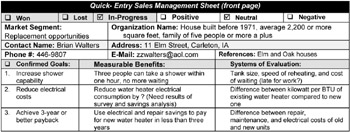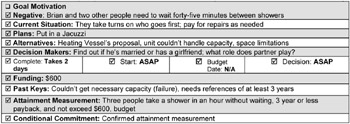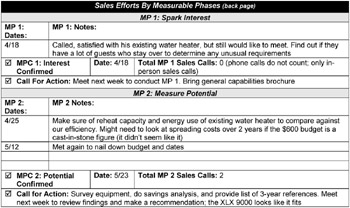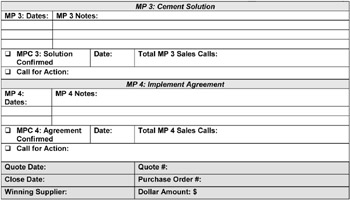MP 2: Measure Potential
The case study continues with the second phase of MP 2: Measure Potential. It begins with John meeting Mr. Walters for the first time at his house. The italics in parentheses will reference the active listening and questioning skills discussed in Chapter 5. Please note how John uses Mr. Walters's responses to acknowledge that he understands his comments. Active listening also gives John time to formulate his follow-up comments and questions. He uses these to reinforce the goals and gather the specifics of the measurable benefits, filters, and systems of evaluations.
Step One: Market Focus
John: Hi, Mr. Walters, John Peters with Water Heaters Inc. Thanks for taking the time to meet with me. As promised, I'll only be about thirty minutes. (John builds an initial trust level by committing to honor his telephone promise about the length of the meeting.)
Brian: Please, John. Call me Brian.
John: OK, Brian. Thanks. I'd like to point out before we start that Water Heaters Inc. has been serving single-family homes' water-heating requirements for over fifty years. Our special emphasis is on homes built before 1971. I'm in my tenth year with the company and have worked successfully with over eight hundred homeowners. (John establishes his and his company's credibility.)
Brian: That's a lot of homes!
John: And a lot of good references. (John acknowledges Brian's comments.)
Step Two: Purpose and Goals
Brian: Well, John. How do you think you can help us? (Brian is ready to discuss business.)
John: Well, Brian, as we discussed on the phone, the reason for our meeting tonight is to first understand your water-heating requirements (goals) and the specifics of your situation. We can then determine what opportunities might exist. In order to gather the details, I'll need to ask you a few questions. How does this approach sound to you? (John verifies the purpose of meeting and seeks his first agreement.)
Brian: Sounds like a good place to start. (customer's agreement)
John: Then, let's get to it. You expressed an interest in reducing your utility bill (goal) as it relates to heating your water. Is that right, and are there any other hot-water issues you have an interest in? (John verifies goal and sees if any others exist before moving on to the filters.)
Brian: Yes, cutting our electric bill wouldn't hurt, but we never seem to have enough hot water in the morning. (Brian explains his goal motivation of avoiding a past negative result; the first influencer filter surfaces.)
John: No one likes a cold shower! How do these two issues rate in importance to you so that we know which one to focus our efforts on first? (John acknowledges his reply by summing up the ramifications of small capacity and why ranking the goals is necessary. This ranking also determines which goal John will use as his safety zone [see Chapter 5]. If necessary, John will reference his questions to Brian's goal to understand how he thinks a filter affects his ability to achieve that goal.)
Brian: I'd rather be warm than save a few bucks. (Capacity is the safety zone goal around which John will reference his filter questions.)
John: Well, let's see if we can't do both. First, we'll need to find out what your specific situation is, OK? (John knows the priority of the goals and reconfirms the need to gather more information.)
Brian: Okay, but I don't have all night. (Customer's verification and a not-too-subtle verbal clue to pick up the pace.)
Step Three: Eliminate Unknowns
Note how John's questions move Brian's response from vague to clearer to measurable. As a reminder, filters are either influencers (I) or prerequisites (P). (Note how John links Brian's measurable answers to the next filter still lacking measurable details.)
John: You're right. I only have twenty minutes left so I'll make each one count. How does your family make do with not enough hot water? (John acknowledges previous response and is seeking current situation [I].)
Brian: Currently, between the five of us, we have to wait between showers. So, we take turns who goes first. It sometimes makes one of us late for work.
John: Typically, how long is your wait? (Clarifying question to get specifics.)
Brian: Oh, about forty-five minutes. It's definitely an inconvenience.
John: Yeah, no one likes waiting—especially if on a tight schedule. How were you planning to shorten your wait time? (John verifies with rephrasing that focuses on the ramifications of the current situation. John then seeks the details of the plans [I].)
Brian: We were looking at adding another water heater for the Jacuzzi we were going to put in, but it didn't make sense to do it at the time.
John: Oh, why's that? (John follows the customer's lead by using a clarifying question to find out specifics concerning plans and alternatives [I].)
Brian: The space limitations wouldn't allow it, and Heating Vessels' single unit wasn't large enough. (John finds out about key to previous failure filter and alternatives, too [I].)
John: If you were able to meet all your requirements, when would you want to do it? (John knows it is still too early to start selling large capacity. He needs to continue qualifying to find out the next filters of budget, decision, start, and complete dates [P]. John knows his goal is to build an inventory of opportunities and then capitalize on them when his strategy dictates. This opportunity occurs when he knows the specifics of the attainment measurement [P].)
Brian: I would do it next week if it could fit our budget. (John is starting to build Brian's attainment measurement [P] and provides start date [P].)
John: What budget have you set for yourself? (John found out two of the dates [P] and took lead from customer to obtain funding [P].)
Brian: I really haven't. I know I don't want to spend more than $600. What does your product cost? (The attainment measurement continues to develop [P]. John has his work cut out for him because XLX 9000 costs around $750.)
John: Yeah, no one wants to spend money without being able to justify it in his mind. Depending on what specific product makes sense for your application, it can cost around $750. However, will that cost difference be an issue if you felt it was worth the money? (John rephrased, verified, and used a clarifying question to seek attainment measurement [P] to determine what Column 2 measurable benefits Brian needs to go ahead with achieving his goals. He also addresses the $600 budget in terms of return on investment.)
Brian: What do you mean?
John: Well, most homeowners think it makes sense to invest in a new water heater if they can recoup their money in less than three years. What are your feelings? (John, as a customer expert, had the SOE of payback ready to discuss with Brian. He did miss an opportunity to find out why Brian has a $600 budget figure. Is it from the previous year's proposal, or just some number he threw out? He can always ask about the figure before he makes his proposal in MP 3: Cement Solution if he or his manager deems it important to know in light of all his other goals and filters.)
Brian: How would I recoup my money in three years?
John: Well, besides energy savings, you won't have any parts or labor repair costs for five years because every new unit has a full parts-and-labor warranty. Before we make any proposal, we will conduct a savings analysis to see exactly what your water heater has been costing you to determine your potential savings and to see if a new one makes financial sense for you. Does this approach work for you? (John shows Brian that he has experience in determining which SOEs might justify a new water heater—and that he does not throw out numbers without researching Brian's situation.)
Brian: Yeah, it does, and a three-year payback seems reasonable. But, not so fast, I still want to be positive that at least three people can take a shower during a one-hour period. (Customer uses systems of evaluation of three-year payback and showers per hour to calculate measurable benefits.)
John: What would make you feel reassured? (John wants to know what will give Brian the reassurances he needs.)
Brian: I'd like to talk to some of your customers who used your products for at least three years. By the way, what product do you have in mind for my situation?
John: I'll send you a list tomorrow of ten people who meet those requirements. I will let them know you'll be calling them. In addition, I can also include their annual savings. As for what specific product to offer, I'd like to see the findings of our survey first. In the interim, I can leave you a brochure that will give you a general overview of our product lines. Also, once we select the best product for your application, I can send you more specific brochures, or even have you visit our showroom to see an actual unit at work. As for the list, will that give you the reassurances about our ability to deliver on our commitments? (John wants Brian to start focusing on dollar savings besides documented performance to help offset his $750 price. He also does not want to get prematurely drawn into a detailed product selection on a yet-to-be determined solution.)
Brian: That'll work.
Step Four: Yellow Light
John: Brian, we went over a lot of details tonight, and I just want to make sure before I leave that I have my facts straight. It seems that if you could get enough hot water for three people in an hour, have a three-year payback savings of $200 annually, and meet your budget of $600—or, if slightly higher, still provide a three-year payback—you would consider that you achieved your goals of reducing electrical costs and increasing capacity. Did I get it right? (John summarizes the attainment measurement, quantifies measurable benefits, and verifies them as Brian's conditional commitment. He does not tie Brian's conditional commitment to any of his specific products. John also recognizes that he will need to address the issue of the $600 budget. He chooses to wait for Brian to talk to his references, and to see if he can beat a three-year payback after conducting his survey. He feels confident Brian will increase his budget to $750 if he can show him a three-year payback or offer a financing program to spread the price over two years.)
Brian: I would definitely go ahead with any water heater that could meet those requirements. (He confirms the requirements of his conditional commitment.)
MPC 2: Potential Confirmed
John: Brian, I would like to suggest that I survey your existing water heater to determine its size, efficiency, and perform the savings analysis. I'll then pursue some possible solutions with my engineering and applications group. This will help me determine what product will work best in your situation. We can then plan to meet next week to review our findings. How does that sound? Is Thursday at the same time good for you? (John verifies the call for action [survey] to work up a yet-to-be-determined product. John does not want to start mentioning products yet. He needs to review all his data with his sales and engineering groups before he commits to a particular product. Furthermore, it sets the purpose for the next meeting—to review his findings. John would also give Brian the opportunity to add, subtract, or modify any goals, filters, systems of evaluations, or measurable benefits.)
Brian: Let's look at my water heater, and then I'll see you next Thursday.
John: Thanks for all your time. I look forward to our meeting. (John got his information; now it's time to go. Anything else said would detract from his efforts. Keep in mind that selling is the ability to gather customer information beneficial to you at a greater rate than you give out product information detrimental to you.)
John Peters has the ability to evaluate his progress by the use of the following modified Q sheet. He generated the appropriate MP 1: Spark Interest before he made his MP 2: Measure Potential in-person sales call to Brian—not afterward. John completes the blank sections in his Q sheet as soon as his in-person sales call ends to evaluate the details he gathered.
You also could use these sheets to measure, manage, and maximize your selling efforts. This recording of essential information takes into account another adage: Sales geniuses know in detail why they are successful so they can repeat their triumphs and avoid failures. (See Exhibits 6-10 and 6-11.)


Exhibit 6-10: Front page of Q sheet.


Exhibit 6-11: Back page of Q sheet.
EAN: 2147483647
Pages: 170